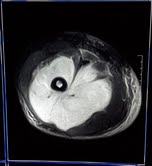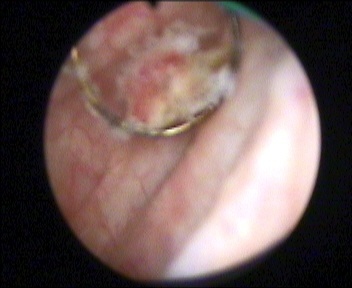-
Paper Information
- Paper Submission
-
Journal Information
- About This Journal
- Editorial Board
- Current Issue
- Archive
- Author Guidelines
- Contact Us
Research In Cancer and Tumor
2013; 2(3): 45-48
doi:10.5923/j.rct.20130203.01
Primary Extra Nodal Non-Hodgkin’s Lymphoma of Urinary Bladder: A Case Report and Brief Review
Takalkar Unmesh V.1, Asegaonkar Shilpa B.2, Asegaonkar Balaji N.1, Kodlikeri Pushpa R.1, Ujwala Kulkarni1, Suresh H. Advani3
1Kodlikeri memorial’s CIIGMA Hospital Jalna road Aurangabad 431001 Maharashtra India
2Goverment Medical College Aurangabad Maharashtra India
3Asian Institute of Oncology S.L.Raheja Hospital, Raheja Hospital Road, Mahim, Mumbai
Correspondence to: Takalkar Unmesh V., Kodlikeri memorial’s CIIGMA Hospital Jalna road Aurangabad 431001 Maharashtra India.
| Email: |  |
Copyright © 2012 Scientific & Academic Publishing. All Rights Reserved.
Primary NHL of urinary bladder is a rare entity representing approximately 0.2% of the primary neoplastic lesions. It is focused in urinary bladder without involvement of surrounding tissues, lymph nodes and bone marrow. A 65 year old lady was diagnosed and managed as Primary NHL of urinary bladder at our center. We managed her exclusively with chemotherapy (CHOP regimen) and now in complete remission of the disease since 5 years. All patients with extra-nodal lymphoma need thorough diagnostic work up like nodal lymphoma to arrive at exact staging of the disease to outline subsequent management.
Keywords: NonHodgekin Lymphoma, Urinary Bladder, Chemotherapy, Cystoscopy
Cite this paper: Takalkar Unmesh V., Asegaonkar Shilpa B., Asegaonkar Balaji N., Kodlikeri Pushpa R., Ujwala Kulkarni, Suresh H. Advani, Primary Extra Nodal Non-Hodgkin’s Lymphoma of Urinary Bladder: A Case Report and Brief Review, Research In Cancer and Tumor, Vol. 2 No. 3, 2013, pp. 45-48. doi: 10.5923/j.rct.20130203.01.
1. Introduction
- Primary extra nodal non-Hodgkin’s lymphomas (NHL) are the lesions arising from the tissue other than lymph nodes and sites which normally do not contain lymphoid tissues. Extra nodal NHLs have diverse anatomic location like gastrointestinal tract, head and neck, skin, central nervous system, bone, testis, breast and thyroid. Rarely do they originate from urinary bladder.[1] These extra nodal NHLs are heterogeneous and complex in their behavior and constitute about 10-20% of all NHL cases.[2]Primary NHL of urinary bladder is a rare entity representing approximately 0.2% of the primary neoplastic lesions. It is focused in urinary bladder without involvement of surrounding tissues, lymph nodes and bone marrow.[3] Due to rarity very few cases have been reported. Herein we describe a case of primary NHL originated from urinary bladder diagnosed and managed at our center.
2. Case Report
- A 65 year old lady was presented with 15 days history of burning micturation and hematuria in 2008. On detail acquisition of history, she had no significant personal and family medical, surgical or urological history. General systemic and gynecological examination was unremarkable. On physical examination there was tenderness in suprapubic region. On palpation there was no evidence of peripheral lymph nodes. Urine analysis revealed microscopic hematuria. Initially an empirical course of antibiotics was administered despite of which her complaints persisted. Routine hematological examination including coagulation profile was within normal limit except for mild hypochromic microcytic anemia (Hemoglobin 9.2 gm/ dl). Serum biochemical and electrolyte parameters were within normal range. Serum Lactate dehydrogenase was elevated to 950 IU/L.Ultrasonography examination of pelvis revealed a large hypo echoic exophytic nonmobile polypoidal mass measuring 12x10x9 cm arising from lateral wall of urinary bladder. This suggested presence of space occupying lesion in bladder. A detailed radiological computed tomography of abdomen was performed which revealed a thickened wall of the urinary bladder. (Figure1.)So we proceeded for urethrocystoscopy which revealed a mass in urinary bladder originating from right lateral wall. (Figure 2) Biopsy was taken from the growth and sent for histopathological examination. Bone marrow biopsy revealed no lymphomatous involvement. Histopathological examination showed presence of diffuse large B cells suggestive of NHL. Further immunohistochemistry analysis supported the diagnosis of B cell lymphoma with positive CLA and CD20 (B- cell marker) and negative for CD3 (T cell marker). As there was no evidence of involvement of lymph nodes on thoracic, pelvic and of spleen on abdominal CT scan, we concluded diagnosis as extra nodal primary NHL of urinary bladder in stage II (T3N0M0). We advised the patient to undergo Positron emission tomography scan from the higher center, as this facility was not available in our city in 2008. But patient was not willing to do so.
 | Figure 1. CT scan image of mass in urinary bladder |
 | Figure 2. Appearance of lesion in urinary bladder during cystoscopy |
3. Discussion
- Carcinoma of urinary bladder is 4th common malignancy in males and 8th in women. Most commonly three types of malignancies are observed 1) Transitional cell carcinoma 2) Squamous cell carcinoma 3) Adenocarcinoma. Primary malignant lymphoma of urinary bladder was first described by Eve and Chaffey in 1885. As lymphoid tissue is not observed normally in urinary bladder, it is relatively uncommon site for primary extra nodal NHL. It accounts for less than 1% of neoplasm in urinary bladder and 0.2% of cases with extra nodal lymphoma.[Jose] About 40% of NHL present in extra-nodal site with skin and gastrointestinal tract, spleen and Waldeyer’s ring being the most frequent site.[4] In 10-20% of terminal NHL cases urinary bladder is affected secondarily. Malignant lymphoma of urinary bladder may be either primary localized to bladder or non-localized from disseminated disease or recurrent involvement. Primary NHL of urinary bladder commonly affects women with female to male ratio of 6.5:1 with underlying cause of chronic cystitis.[5] Smoking, environmental factors, family history of malignancy are causative factors for development of carcinoma bladder. Tumor associated with chronic cystitis may originate in the lymphocytes of the submucosa of bladder because of inflammatory response. In our case no significant risk factor or family history was significant contributing to this disease. Presenting variable symptoms include intermittent hematuria, dysuria, nocturia, urinary frequency, pain in lower abdomen and frequent or recurrent urinary tract infections. Mean age for presentation is 64 years.[6, 7]M. SOnmezer et al described a case of primary lymphoma of urinary bladder presenting as a large pelvic mass with genitourinary bleeding. They managed it by partial cystectomy followed by 4 cycles of CHOP regimen.[2] A.W.Bates and colleagues studied 11 cases of primary and secondary malignant lymphoma of the bladder and reported favorable outcome in primary cases.[8] Hayashi A. et al reported primary DCBCL of bladder in a 75 year old woman presented as acute renal failure and effectively treated by 3 cycles of R-CHOP chemotherapy to attain clinical remission.[9] Hughes M studied 12 patients of primary bladder lymphoma in whom overall survival was 75%, mean follow up of 4.8 years supporting good prognosis. Ureteric obstruction, hydronephrosis, fistulas and acute renal failure are the serious complications.[10] Jose A Diaz- Peromingo emphasized the need for extensive lymphoma staging by PET implementation for proper management in their case report.[6] Irfan Maghfoor et al reported primary extra-nodal lymphoma of bladder in 59 year old woman presented with dysuria. She was managed by partial cystectomy and chemotherapy.[11] Alberto A Antunes reported case of 41 year lady with secondary lymphoma of bladder after treatment for NHL.[12] Among Indian population uptil now only 1 case report of primary diffuse large B cell lymphoma of urinary bladder has been described.[13]Commonly such lesions are initially diagnosed as uothelial carcinoma of the bladder. But tissue biopsy, immunohistochemistry play important role in the diagnosis of primary NHL. Primary bladder lymphomas are of two types- 1. Mucosa associated lymphoid tissue (MALT) 2. Diffuse large B cell type of lymphoma (DLBCL). MALT type lymphoma is more common. Secondary involvement of the bladder by systemic lymphoma has been documented in 10-20% of NHL patients at necropsy.[8] Bladder lymphoma usually locates at the base and the trigone of the bladder as a sessile mass with normal urothelium. CT scans and MRI examination usually do not add much information for diagnosis due to their low sensitivity. But cystoscopy, histological examination and immunohistochemistry play major role for diagnosis of the disease.[14] Even if the condition is rare, possibility of malignant lymphoma should be always kept in mind for differential diagnosis of bladder tumor. Because once diagnosed there is chance of excellent complete remission of the lymphoma resulting in good prognosis.The factors that should be taken into consideration to outline the management of such patients are age, performance and physiologic status of the patient, stage of tumor and International Prognostic Index (IPN). Calculating IPN which depends on age, stage, serum lactate dehydrogenase, number of extra nodal sites involved and performance status helps to determine the prognosis of the patient. There are different therapeutic strategies available for primary extra-nodal NHL. Therapeutic options available are radical cystectomy, radiation therapy and chemotherapy depending upon the clinical behavior of tumor, risk of disease progression, life expectancy and general condition of the patient. Patient’s fitness for chemotherapy, radiotherapy and surgery matters the decision for management. Total surgical resection has impact on quality of life.The indexed case has been highlighted for its rarity. We described clinical features and diagnostic and therapeutic modalities in the management of primary extra nodal NHL of urinary bladder. As there are no clear therapeutic guidelines for managing such cases, present case will add to the present literature. In summary we report a case of primary extra nodal NHL of urinary bladder managed with multimodality treatment.
4. Conclusions
- We present a rare case of primary extra nodal NHL of urinary bladder in a 65 year old female. We also described a brief review of the literature emphasizing the clinicopathological features, various diagnostic and therapeutic modalities and clinical outcome for primary malignant lymphoma of urinary bladder. All patients with extra-nodal lymphoma need thorough diagnostic work up like nodal lymphoma to arrive at exact staging of the disease to outline subsequent management."Written informed consent was obtained from the patient for publication of this case report and accompanying figures.”
 Abstract
Abstract Reference
Reference Full-Text PDF
Full-Text PDF Full-text HTML
Full-text HTML